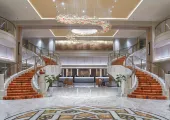A Medieval Journey Through Time and Space in The Renaissance City
Catalogue
- 1.The Uffizi Gallery
- 2.The Boboli Gardens
- 3.The Medici Palace
- 4.The Galileo Museum
- 5.Casa Di Dante
- 6.Santa Croce of Florence
- 7.Palazzo Pitti
- 8.Museo Nazionale Del Bargello
- 9.Gelleria Dell Accademia
- 10.Battistero Di San Giovanni
Show More
Florence is the world-famous capital of the Renaissance. The world-famous Medici family has historically funded the development of local arts, and many treasures have been preserved during the Medici palace. Now let's take a closer look at the most famous Renaissance buildings in the city and the works left by Michelangelo and other Renaissance masters. Among them, the Uffizi Gallery, the most influential gallery in Europe, must not be missed.
The Uffizi Gallery near the Piazza della Signoria is one of the best art galleries in Italy and even in Europe. It was once the office of the Medici family. The family donated all the works of art collected for generations. These works of art have been preserved as part of the city's heritage. The must-see works include, for example, "The Birth of Venus" and "Spring" by Sandro Botticelli, and "Annunciation" by Leonardo da Vinci.
The gallery has a collection of more than 100,000 pieces, covering much of the history of European art, from ancient Greek sculptures to 18th-century Venice oil paintings. The second floor is the National Library. The third floor is the essence of the gallery, with 46 studios and 3 corridors, including masterpieces by Raphael, Titian, Rubens, Michelangelo and Botticelli.
It is suggested that you rent an audio guide at the entrance of the third floor, and get the pamphlet of the layout of each studio. In addition, the gallery has a rooftop cafe. On its viewing platform, you can also overlook the Piazza della Signoria and the scenery around the river Arno.
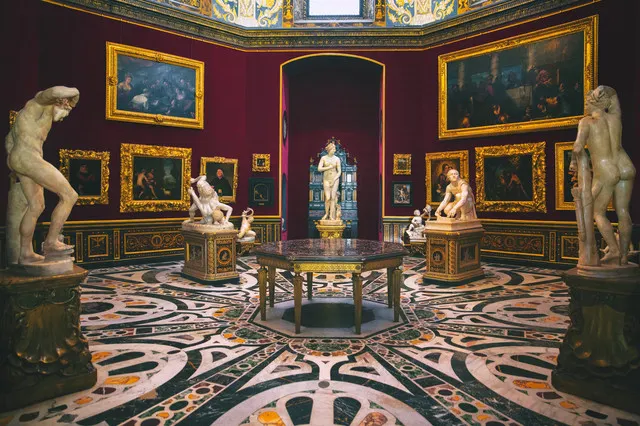
The Medici family built an ancient Roman garden behind Palazzo Pitti: the Boboli Gardens. This was originally the family's private courtyard. It is built against a sloping hill, and its unique location makes it less neat and symmetrical than most European gardens. It is recommended that you climb the hillside, Forte Belvedere, behind the garden, and you can overlook Basilica di Santa Maria del Fiore and the city scenery of Florence.
The garden designer made decorations like garden trails, fountains, exquisite sculptures and other decorations according to the travel route. This Italian palace garden design and layout has also become the blueprint for many European palace gardens. When you stroll along the trails, it is like reliving the luxurious outdoor life in the palace. The garden was also included in the World Heritage List in 2013.

The full name of Medici Palace is Palazzo Medici-Riccardi, where members of the Medici family lived and worked for nearly 100 years since the 15th century. At first glance, this building is unexpectedly simple, with a low-key and light appearance derived from innovative marble masonry techniques, which has also become a model and influenced many subsequent family palace designs, such as the Palazzo Pitti in the same city.
In Florence, there aren't too many works of art in the palace compared with other art galleries. The most popular ones are the "Journey of the Magi" in the upstairs Capella dei Magi and the ceiling mural "Allegory of Divine Wisdom" in the hall. It is said that the palace was deliberately designed to be simple and unadorned in those days, because the new Florentine lord deeply understood that excessively magnificent palaces would attract citizens' resentment, which was more terrible than anything else.

The Galileo Museum has collected various scientific instruments from the Renaissance to the present. Some people say that it is like a retrospective exhibition of high school physics, while others say that it can satisfy all your imagination about medieval technology. The museum displays all kinds of ingenious devices that look great. Most unimaginable of all, Galileo's fingers and teeth, and ancient medical models can also be seen.
The oldest collection in the museum is the private collection of the Medici and Lorraine families. The most famous exhibit is the telescope used by Galileo in 1609. Galileo used it to discover the lunar mountains and the Galileo Satellite, and these discoveries supported Copernicus's heliocentric theory. In addition, a mercury barometer invented in 1634 is also exhibited here.
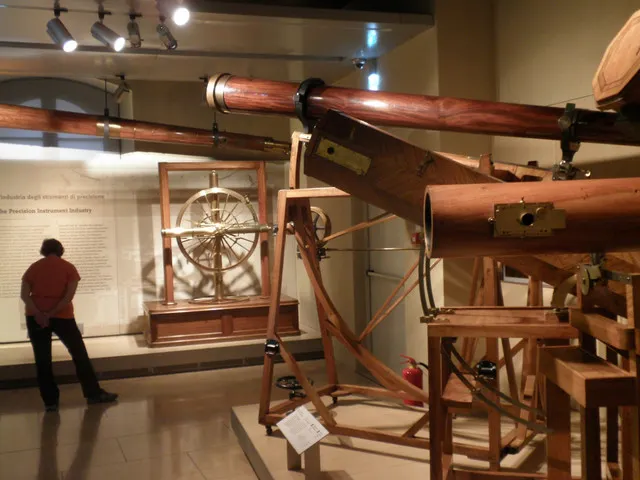
Dante is a great poet from the early days of the Italian Renaissance and the founder of modern Italian. He is known for his masterpieces Divine Comedy and New Life. His old house, a medieval tower, located in an alley of the ancient city, has now been turned into the Museo della casa di Dante. In this three-story old building, some of Dante's works and family albums, as well as scenes of Dante's family, are presented in front of you.
In Italy, you can always find the shadow of Dante. If you are interested in the Renaissance or Dante, it is recommended that you visit his former residence (Casa di Dante), but if you are not interested, you may find it a little boring. In addition, street performers dressed as Dante sometimes recite the Divine Comedy at the gate of Casa di Dante.
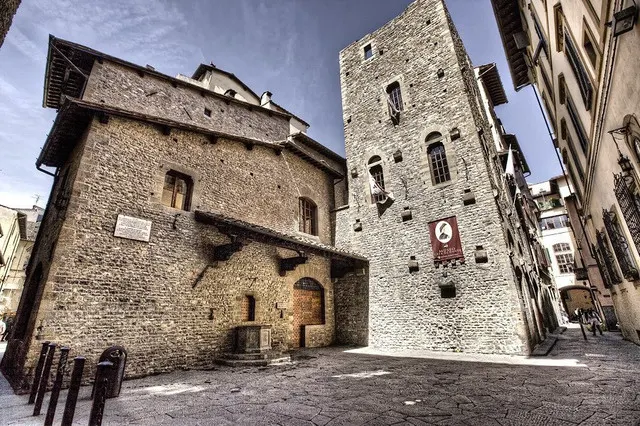
Santa Croce of Florence is located in the Piazza Santa Croce. The church is called the resting place of Italian masters of humanities, including the famous Dante, Galileo and Michelangelo. The works of the three masters alone make up almost half of the Italian art history of humanities.
The floor of the church, from the entrance to the three main halls, is paved with old tombstones. The interior of the church is grand. The exquisite glass windows are works from the late 14th century. The church has 16 chapels, of which Pazzi Chapel deserves a good visit, especially the mural "The Legend of the Holy Cross" and the "Madonna and Saints" on the altar.
Palazzo Pitti is near the Ponte Vecchio Bridge, and is opposite to the Old Town Florence across the river. This Renaissance palace was originally the residence of the banker Pitty. Later, it was bought by the Medici family as the main residence, and the family collected many works of art and treasures in it. It is now open to the public as an art museum.
Palazzo Pitti is full of glittering salons. Various paintings and sculptures create a strong artistic atmosphere. The focus of the visit is the Palatine Gallery, where works by artists including Raphael, Botticelli and Titian can be seen.
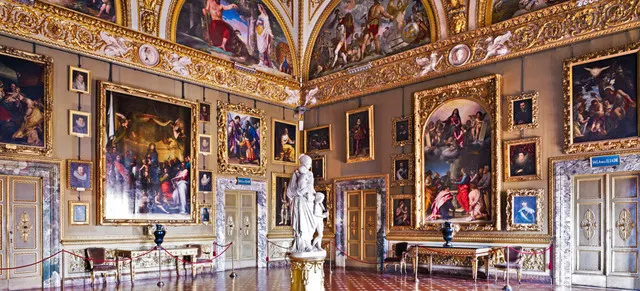
While it once served as a military camp and a prison, Museo Nazionale del Bargello is now Florence's second largest national museum. The building itself is representative of the ancient Gothic style. The most precious treasure of the museum in this three-story art museum is the "Bacchus" on the first floor. This is Michelangelo's "debut work" at the age of 21: The appearance of Bacchus being slightly drunk is very vivid.
The first thing you can see when you enter the art museum is a courtyard with various sculptures, such as Venus Fountain and Emperor's Crown. The ceiling of the corridor is drawn with large satellites as the basic elements and is worth visiting. In the exhibition hall on the first floor, Michelangelo's relief work Madonna and Child and Giambologna's Mercury are worth visiting.
On the second floor, works from the late 14th century to the 15th century, represented by Donatello's works, are on display. On the third floor, exhibits, such as medals, textiles, tapestries, ivory fabrics, silverware, armor and coins of the Medici family, can also be seen.
Gelleria dell Accademia is the world's first academy of fine arts, enjoying the title of "the mother of the world academy of fine arts and the head of the four major art academies". Founded in 1561 with the support of the Medici family, It has trained numerous world-renowned artists, including Leonardo da Vinci, Michelangelo, Galileo and Titian.
The most precious treasure in Gelleria dell Accademia is the famous Statue of David. It took Michelangelo 4 years to finish the statue. The statue was carved from a single piece of pure white marble. David's skin, blood vessels and joints are very lifelike!
Battistero di San Giovanni is the baptistery of Basilica di Santa Maria del Fiore. The octagonal building has 3 entrances. The embossed panels of the east gate are all gilded, and designed and cast by Lorenzo Gilberti. Michelangelo called it the gate of heaven. However, the panels on the door are now replicas, and the genuine panels are preserved in the museum inside the church, covered in glass, glittering.
Lorenzo Gilberti, the designer of the door, was only 23 when he was commissioned to start the design. Over the next 50 years, he cast bronze plates over and over again until he thought the reliefs were perfect. In 1456, he was already 73 years old, and the gold-plated bronze door panels were finally presented to the world. There were 10 reliefs on the door telling the story of the Old Testament.
Trending Travelogues
Popular Trip Moments
Popular Travel Types
Popular Attractions
Popular Ranked Lists
Popular Destinations
Recommended Attractions at Popular Destinations
About











Site Operator: Trip.com Travel Singapore Pte. Ltd.

